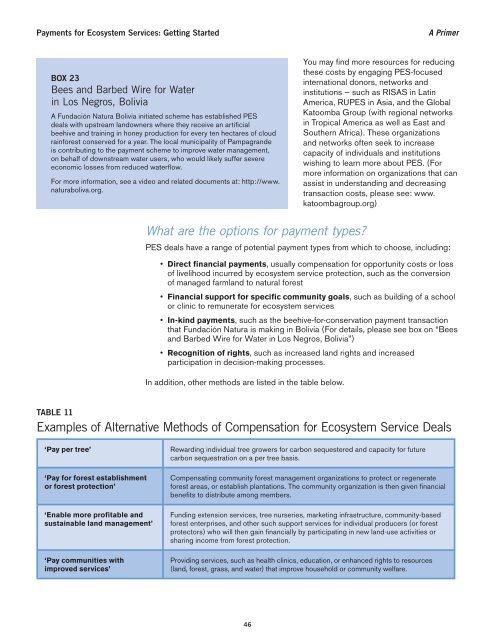Payments for Ecosystem Services: Getting Started. A Primer - UNEP
Payments for Ecosystem Services: Getting Started. A Primer - UNEP
Payments for Ecosystem Services: Getting Started. A Primer - UNEP
You also want an ePaper? Increase the reach of your titles
YUMPU automatically turns print PDFs into web optimized ePapers that Google loves.
<strong>Payments</strong> <strong>for</strong> <strong>Ecosystem</strong> <strong>Services</strong>: <strong>Getting</strong> <strong>Started</strong><br />
A <strong>Primer</strong><br />
BOX 23<br />
Bees and Barbed Wire <strong>for</strong> Water<br />
in Los Negros, Bolivia<br />
A Fundación Natura Bolivia initiated scheme has established PES<br />
deals with upstream landowners where they receive an artifi cial<br />
beehive and training in honey production <strong>for</strong> every ten hectares of cloud<br />
rain<strong>for</strong>est conserved <strong>for</strong> a year. The local municipality of Pampagrande<br />
is contributing to the payment scheme to improve water management,<br />
on behalf of downstream water users, who would likely suffer severe<br />
economic losses from reduced waterfl ow.<br />
For more in<strong>for</strong>mation, see a video and related documents at: http://www.<br />
naturaboliva.org.<br />
You may fi nd more resources <strong>for</strong> reducing<br />
these costs by engaging PES-focused<br />
international donors, networks and<br />
institutions — such as RISAS in Latin<br />
America, RUPES in Asia, and the Global<br />
Katoomba Group (with regional networks<br />
in Tropical America as well as East and<br />
Southern Africa). These organizations<br />
and networks often seek to increase<br />
capacity of individuals and institutions<br />
wishing to learn more about PES. (For<br />
more in<strong>for</strong>mation on organizations that can<br />
assist in understanding and decreasing<br />
transaction costs, please see: www.<br />
katoombagroup.org)<br />
What are the options <strong>for</strong> payment types?<br />
PES deals have a range of potential payment types from which to choose, including:<br />
• Direct financial payments, usually compensation <strong>for</strong> opportunity costs or loss<br />
of livelihood incurred by ecosystem service protection, such as the conversion<br />
of managed farmland to natural <strong>for</strong>est<br />
• Financial support <strong>for</strong> specific community goals, such as building of a school<br />
or clinic to remunerate <strong>for</strong> ecosystem services<br />
• In-kind payments, such as the beehive-<strong>for</strong>-conservation payment transaction<br />
that Fundación Natura is making in Bolivia (For details, please see box on “Bees<br />
and Barbed Wire <strong>for</strong> Water in Los Negros, Bolivia”)<br />
• Recognition of rights, such as increased land rights and increased<br />
participation in decision-making processes.<br />
In addition, other methods are listed in the table below.<br />
TABLE 11<br />
Examples of Alternative Methods of Compensation <strong>for</strong> <strong>Ecosystem</strong> Service Deals<br />
‘Pay per tree’<br />
‘Pay <strong>for</strong> <strong>for</strong>est establishment<br />
or <strong>for</strong>est protection’<br />
‘Enable more profitable and<br />
sustainable land management’<br />
‘Pay communities with<br />
improved services’<br />
Rewarding individual tree growers <strong>for</strong> carbon sequestered and capacity <strong>for</strong> future<br />
carbon sequestration on a per tree basis.<br />
Compensating community <strong>for</strong>est management organizations to protect or regenerate<br />
<strong>for</strong>est areas, or establish plantations. The community organization is then given fi nancial<br />
benefi ts to distribute among members.<br />
Funding extension services, tree nurseries, marketing infrastructure, community-based<br />
<strong>for</strong>est enterprises, and other such support services <strong>for</strong> individual producers (or <strong>for</strong>est<br />
protectors) who will then gain fi nancially by participating in new land-use activities or<br />
sharing income from <strong>for</strong>est protection.<br />
Providing services, such as health clinics, education, or enhanced rights to resources<br />
(land, <strong>for</strong>est, grass, and water) that improve household or community welfare.<br />
46
















